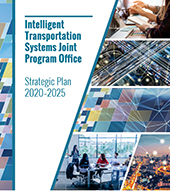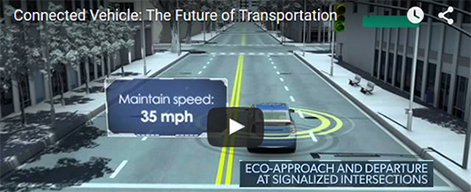About ITS JPO
2012 Report to Congress
Intelligent Transportation Systems (ITS)
Program Advisory Committee (PAC)
2013 Report to Congress
1. Overview
- a. Pursuant to Section 53003 of the Moving Ahead for Progress in the 21st Century Act (MAP-21), this report provides a summary of preliminary observations made by the Intelligent Transportation Systems (ITS) Program Advisory Committee (ITS PAC or Committee) in 2012. The ITS PAC will make formal recommendations in the final memorandum of 2013.
- b. The Secretary was directed, initially in the Safe, Accountable, Flexible, Efficient Transportation Equity Act: A Legacy for Users (SAFETEA-LU) and again in MAP-21, to establish the Committee with no more than 20 members to provide advice to the Secretary on ITS aspects of the Department’s strategic plan and on ITS research funding. The Secretary is directed also to submit a report to Congress not later than February 1 of each year that includes the following:
- all recommendations made by the Committee during the preceding calendar year;
- an explanation of the manner in which the Secretary has implemented those recommendations; and
- for recommendations not implemented, the reasons for rejecting the recommendations.
- In response to the legislative directive, the Secretary established the ITS PAC in 2006. Since its inception, the ITS PAC has met 15 times and has submitted 5 advice memoranda to the Secretary.
2. Summary of ITS PAC Activity To Date
- a. In March of 2012, ITS PAC membership was reconstituted with 13 new and 7 returning members. The previous Vice Chairman, Mr. Robert Denaro, was appointed Chairman, and Prof. Hans Klein of the Georgia Institute of Technology was appointed Vice Chairman. The newly reconstituted Committee held two in-person meetings, a web conference and a teleconference in 2012. The Department briefed the newly reconstituted Committee on the ITS Research Program’s current major focus on the safety benefits of Connected Vehicle (CV) technologies. The Department also described the major challenges facing the successful development and deployment of these technologies and requested the Committee’s thoughts on addressing these challenges. In response, the Committee identified five topics that it considers relevant to the ITS Research Program and that would form the basis of its future advice to the Secretary. The Committee developed a five-subcommittee structure to study topics and established major milestones to deliver an initial memorandum of preliminary observations to U.S. DOT (described in paragraph 3 below) and a final advice memorandum to the Secretary by December 2013. The ITS PAC also concluded that its collective expertise could make a valuable contribution to the impending National Highway Traffic Safety Administration (NHTSA) decision on vehicle-to-vehicle capabilities, a subset of CV technologies; accordingly, the Committee work plan includes presenting U.S. DOT informal recommendations relevant to the decision by late summer of this year.
- b. The Committee currently is in the initial stages of planning its next meeting in Washington, DC on March 27 to 28, 2013.
3. ITS PAC February 12, 2013, Memorandum of Preliminary Observations
The ITS PAC made no formal recommendations to the U.S. Department of Transportation during 2012; however, ITS PAC’s preliminary observations include the following:
- Technology considerations including bandwidth and scalability are both critical areas within the CV program and will need to be monitored for any sign of anomalies.
- Cost considerations and business model development will be highly sensitive and an important factor in the program. Consumer price sensitivity will be especially important if there are high expectations for aftermarket deployment, where cost is borne directly by the consumer and is therefore very visible.
- The security requirements of the CV systems remain a significant challenge to the program and the balance of privacy and security will demand a very tight focus by the ITS Joint Program Office (JPO).
- Transit and commercial vehicle operations are well-suited to the CV program and important benefits are possible with continued research.
- Roles and responsibilities are still evolving and will need to be firmly established as deployment nears, perhaps including benchmarks and a timeline to ensure a smooth transition.
- The ITS JPO should continue to focus on developing a broad based communications plan targeting multiple areas including internal and external stakeholder audiences, public, private, and multiple levels of government. The plan is needed both leading up to and continuing after the NHTSA decision in 2013.
- Dedicated short range communication (DSRC) 5.9 GHz is critical to the success of the program. The ITS JPO should continue to work with the National Telecommunications and Information Administration and Federal Communications Commission to evaluate and ensure adequate bandwidth is available for vehicle safety applications.
- It is critical that the U.S. Government invest adequate political capital, time, and financial resources in the standards development and harmonization processes to maximize benefits. International standards and harmonization is important not only for the CV program but also for the other segments of ITS. If the U.S. is to remain globally competitive, it must engage in significant efforts in this area, which is outside the scope of the current international standards harmonization program currently limited to the CV program.
- Building robust and dynamic markets may present challenges to the CV program. Incentives for early deployment may not be strong and may have to be developed, potentially applying to both original equipment manufacturers and aftermarket device suppliers.
The ITS JPO concurs that the above observations are worthy of full consideration and will provide a useful structure for a substantive dialogue with the Committee membership. The observations and forthcoming informal recommendations will serve as input to the planning and execution of the ITS research agenda.










